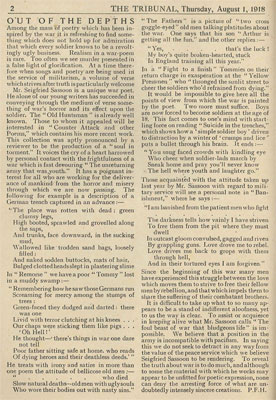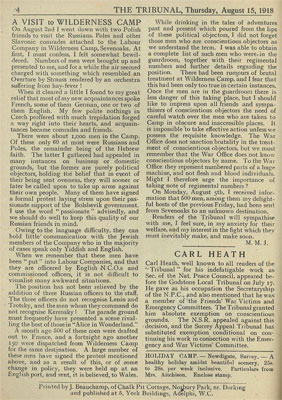
| HOME | TRIBUNAL HOME |
August 1918
In many ways, August 1918 would see the beginning of the end of the war. Conscription had been rolled out to it’s maximum extent, the Entente nations seemed on the brink of major victories on every front, and even the Conscientious Objectors still resisting the military in prison looked to be receiving better conditions in the near future. The Tribunal, under pressure from the government and police, faced with heavy paper rationing and an understandable war-fatigue, filled the five August issues with reprints and reviews, though developments overseas would give a new impetus to the struggle against war by the end of the month.
August 1st: Out of the Depths
The great soldier-poets of the First World War turn up, regular as clockwork, every November, their words put to use by the Peace Movement, the Government and the Military. For every bitterly worded “Dulce et Decorum est”, there’s a McCrae, exhorting a new generation of soldiers to take the fight onwards. Back in 1918, the situation was little different, though, while patriotic poems abounded, the anti-war voice was less well developed - at least until the publication of Sassoon’s anthology “Counter-Attack and other poems”. Counter-Attack was a scathing and bitter attack on the war, the suffering of war and those who had perpetuated it through patriotism, nationalism and empty promotion of glory. It was, as you’d expect, well received in the NCF Offices.
 Sassoon’s “Counter-Attack” and “Suicide in the Trenches” are quoted as examples of poetry that “has a poignant interest for all who are working for the delivery of mankind from the horror and misery through which we are now passing”, and while the Tribunal is careful to point out that “to some the material with which he works may be unfitted for poetic expression”, the collection is certainly an “arresting force” and a testament to the horror of war.
Sassoon’s “Counter-Attack” and “Suicide in the Trenches” are quoted as examples of poetry that “has a poignant interest for all who are working for the delivery of mankind from the horror and misery through which we are now passing”, and while the Tribunal is careful to point out that “to some the material with which he works may be unfitted for poetic expression”, the collection is certainly an “arresting force” and a testament to the horror of war.
We’ve written about war poetry before here at the PPU, but the Tribunal review of Counter-Attack raises important issues that the Peace Movement of today is still not entirely comfortable with - how much do we rely on the testimony of soldiers against war? Can we be anti-war without being anti-soldier?
The article has a clear reluctance to engage with what drove Sassoon to enlist - still less to acknowledge that he was willing to return to the war. The Tribunal acknowledges the struggle that “impels them [soldiers] to share in the suffering of their combatant brothers” - an issue that we know plagued many Absolutist COs. But then, states “A position in the army is incompatible with pacifism”, hedging it’s bets by following this with “we do not seek to detract in any way from the value of the peace service which we believe Seigfried Sassoon to be rendering”.
Sassoon would go on to have a difficult relationship with the pacifist movement - an early supporter of the Peace Pledge Union, he would withdraw his support in 1940. An awkward compromise on all sides, then - but the issue remains, from then until the modern day.
August 15th: A Visit to Wilderness Camp
One of the forgotten stories of the First World War is the disastrous and pointless British, French and US intervention in the Russian Civil War. British forces had been deployed as early as June, but August saw the first mass landing in Arkhangelsk. Opening up another front in the war (which would last well into 1920), invading a country solely to force it back into a war it had left, inevitably prolonging a disastrous civil war, doing so almost entirely secretly and creating a whole new group of Conscientious Objectors.
Conscripts from “alien nations”, even friendly ones, occupied an awkward position in the army. Reports from Wilderness Camp show that Russian and Polish conscripts were being held as labour battalions, soon to be sent to France to replace British men behind the lines who were capable of fighting. Many more men were needed - especially with the opening of another front in Russia.
 Around 1,000 men were reported to be in Wilderness Camp, expecting to be shipped across to France and beginning to actively resist. Russian and Polish citizens, many of them were Jewish, and often Communist, making a volatile mix of politics and religion that led to widespread dissent. The Tribunal was less concerned with supporting their resistance - understanding that their “passionate support of the Bolshevik Government” would lend these men strength enough to protest, but clarifying the legality of the situation. Without the protection of legal conscientious objector status, the treatment of the men at Wilderness Camp was not bound by the same laws. Already rumours of brutal treatment, and men being taken to “obscure and inaccessible places” were rife, and the NCF watched anxiously for any new developments.
Around 1,000 men were reported to be in Wilderness Camp, expecting to be shipped across to France and beginning to actively resist. Russian and Polish citizens, many of them were Jewish, and often Communist, making a volatile mix of politics and religion that led to widespread dissent. The Tribunal was less concerned with supporting their resistance - understanding that their “passionate support of the Bolshevik Government” would lend these men strength enough to protest, but clarifying the legality of the situation. Without the protection of legal conscientious objector status, the treatment of the men at Wilderness Camp was not bound by the same laws. Already rumours of brutal treatment, and men being taken to “obscure and inaccessible places” were rife, and the NCF watched anxiously for any new developments.
22nd August: Walton Gaol
Fenner Brockway, co-founder of the NCF was a surprisingly rare visitor to the pages of the Tribunal. Aside from the fact that he was in prison, he seems to have received far less column inches updating NCF members on his situation than other key COs like Walter Ayles, W.J Chamberlain and Clifford Allen. The August 22nd issue goes some way towards explaining why.
From 1916 onwards, Fenner had been through the same sentence-release cycle as other Absolutist COs, but in May 1918 in a concerted protest against prison conditions, he declared that he would no longer be bound by prison rules. Breaking the rule of silence without regard for consequences allowed him to organise collective action, and though punishment followed, the COs in Walton prison went on strike.
In this case, the strike simply led to the men involved being separated at different prisons. But the possibilities inherent in collective action from within prison were raised - and spreading the ringleaders around the country encouraged their actions to spread. The government, uneasy at the prospect of outright and complete disobedience in prisons around the country, watched, and September would see the results of their deliberations.
Clink on images to enlarge